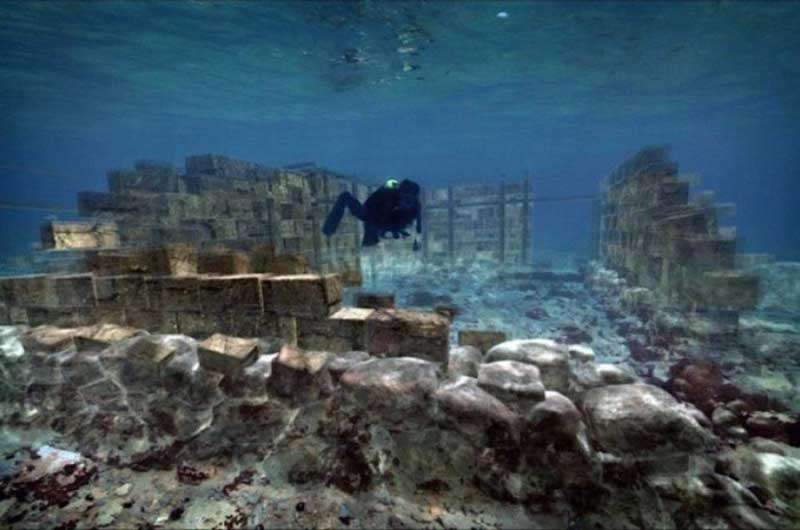
From the legendary sunken island of Atlantis to Ville d’Ys, the mythical drowned city off the coast of Brittany, there are several mythical stories and folklore about the ancient cities swallowed by the sea. But more fascinating than those fictional cities lost under the sea are the real ones that dot the coastlines around the world. One of such ruins of a submerged city was discovered by British scientist Nicholas Flemming in 1967, near the islet of Pavlopetri off the coast of Laconia in Greece, and immediately after the discovery, it was mapped in 1968 by a team of archaeologist from Cambridge. The ruins contained 15 houses, 37 graves, several streets, and innumerable fragments of pottery. It was considered that it was an ancient city, submerged around 13 feet (4 m) underwater, with incredibly well-designed streets, two-story buildings, temples, a cemetery, and a network of the water management system, complete with channels and water pipes. There was also a plaza, measuring about 130x65 feet (40x20 m), in the centre of the city, and most of the building contained 12 rooms.

However, the fact is, nobody is sure about the definite name of the city as it sank deep into the Mediterranean Sea off the southern tip of the Peloponnese peninsula of Greece about 5000 years ago, making it one of the oldest of the lost submerged cities. That the city is ancient is evident by the fact the Greek epic Iliad, usually considered to have been written in the 8th century BC, was set in the city. Pavlopeti, literally translates to Paul’s Stone, referring to St. Paul, the Christian apostle, is the modern name for the inlet where the submerged ruins were found. Originally, it was assumed to be a part of the Mycenaean civilization. But the theory was discarded in 2009, when a team of archaeologists dated a shard of pottery from the site to about 3000 BC. Research in 2009 also revealed that the site extends to roughly 9 acres, and there is enough evidence to indicate that it had been inhabited before 2800 BC. Today, the scholars think that possibly Pavlopeti belonged to the Minoan civilization on Crete, who probably occupied the city through the Bronze Age until roughly 1000 BC, when the city was submerged by the effect of the first of three earthquakes that the area suffered, which shifted the land and collapsing the city into the sea.

However, although the ancient city, long lost from the face of the earth and submerged in the sea, is incredibly well maintained, as its location was unknown until 1967, and it remained comparatively inaccessible. Although eroded over the centuries, and the site is always under the threat of damage by boats dragging anchors, as well as by the souvenir hunters, the town layout is almost as it was thousands of years ago. Apart from the tourists, the site is equally attractive and interesting to the oceanographers, archaeologists, and historians for its unique layout and advanced infrastructure. Even, the head of the archaeological team, John Henderson of the University of Nottingham, has created what they believe an accurate 3D reconstruction of the submerged city. Along with them, a team from the Australian Centre for Field Robotics is also working intending to take an underwater archaeological survey of the site with the help of robots and developed several unique robots for the purpose.

As there is enough evidence of human existence for more than one hundred years, the submerged city of Pavlopetri is a part of the UNESCO Underwater Cultural Heritage and it is protected by the UNESCO Convention on the Protection of the Underwater Cultural Heritage, aiming at preventing the destruction or loss of any part of it and protect the cultural heritage site with an international legal framework.